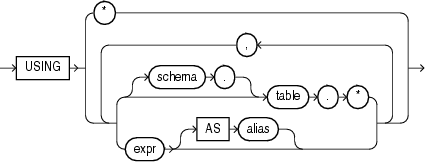| Oracle® Database SQL Reference 10g Release 2 (10.2) Part Number B14200-01 |
|
|
View PDF |
| Oracle® Database SQL Reference 10g Release 2 (10.2) Part Number B14200-01 |
|
|
View PDF |
Syntax

mining_attribute_clause::=

Purpose
This function is for use with clustering models that have been created with the DBMS_DATA_MINING package or with the Oracle Data Mining Java API. It returns a varray of objects containing all possible clusters that a given row belongs to. Each object in the varray is a pair of scalar values containing the cluster ID and the cluster probability. The object fields are named CLUSTER_ID and PROBABILITY, and both are Oracle NUMBER.
For the optional topN argument, specify a positive integer. Doing so restricts the set of predicted clusters to those that have one of the top N probability values. If you omit topN or set it to NULL, then all clusters are returned in the collection. If multiple clusters are tied for the Nth value, the database still returns only N values.
For the optional cutoff argument, specify a positive integer to restrict the returned clusters to those with a probability greater than or equal to the specified cutoff. You can filter only by cutoff by specifying NULL for topN and the desired cutoff value for cutoff.
You can specify topN and cutoff together to restrict the returned clusters to those that are in the top N and have a probability that passes the threshold.
The mining_attribute_clause behaves as described for the PREDICTION function. Please refer to mining_attribute_clause.
|
See Also:
|
Examples
The following example lists the most relevant attributes (with confidence > 55%) of each cluster to which customer 101362 belongs with > 20% likelihood.
This example, and the prerequisite data mining operations, including the creation of the dm_sh_clus_sample model and the views and type, can be found in the demo file $ORACLE_HOME/rdbms/demo/dmkmdemo.sql. General information on data mining demo files is available in Oracle Data Mining Administrator's Guide. The example is presented here to illustrate the syntactic use of the function.
WITH
clus_tab AS (
SELECT id,
A.attribute_name aname,
A.conditional_operator op,
NVL(A.attribute_str_value,
ROUND(DECODE(A.attribute_name, N.col,
A.attribute_num_value * N.scale + N.shift,
A.attribute_num_value),4)) val,
A.attribute_support support,
A.attribute_confidence confidence
FROM TABLE(DBMS_DATA_MINING.GET_MODEL_DETAILS_KM('km_sh_clus_sample')) T,
TABLE(T.rule.antecedent) A,
km_sh_sample_norm N
WHERE A.attribute_name = N.col (+) AND A.attribute_confidence > 0.55
),
clust AS (
SELECT id,
CAST(COLLECT(Cattr(aname, op, TO_CHAR(val), support, confidence))
AS Cattrs) cl_attrs
FROM clus_tab
GROUP BY id
),
custclus AS (
SELECT T.cust_id, S.cluster_id, S.probability
FROM (SELECT cust_id, CLUSTER_SET(km_sh_clus_sample, NULL, 0.2 USING *) pset
FROM km_sh_sample_apply_prepared
WHERE cust_id = 101362) T,
TABLE(T.pset) S
)
SELECT A.probability prob, A.cluster_id cl_id,
B.attr, B.op, B.val, B.supp, B.conf
FROM custclus A,
(SELECT T.id, C.*
FROM clust T,
TABLE(T.cl_attrs) C) B
WHERE A.cluster_id = B.id
ORDER BY prob DESC, cl_id ASC, conf DESC, attr ASC, val ASC;
PROB CL_ID ATTR OP VAL SUPP CONF
------- ---------- --------------- --- --------------- ---------- -------
.7873 8 HOUSEHOLD_SIZE IN 9+ 126 .7500
.7873 8 CUST_MARITAL_ST IN Divorc. 118 .6000
ATUS
.7873 8 CUST_MARITAL_ST IN NeverM 118 .6000
ATUS
.7873 8 CUST_MARITAL_ST IN Separ. 118 .6000
ATUS
.7873 8 CUST_MARITAL_ST IN Widowed 118 .6000
ATUS
.2016 6 AGE >= 17 152 .6667
.2016 6 AGE <= 31.6 152 .6667
.2016 6 CUST_MARITAL_ST IN NeverM 168 .6667
ATUS
8 rows selected.